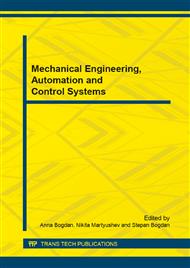[1]
R.Z. Valiev, N.A. Enikeev, M. Yu. Murashkin, et al., On the origin of the extremely high strength of ultrafine-grained Al alloys produced by severe plastic deformation, Scripta Materialia. 63 (2010) 949–952.
DOI: 10.1016/j.scriptamat.2010.07.014
Google Scholar
[2]
V.A. Pozdnyakov, Ductility of nanocrystalline materials with a bimodal grain structure. Tech. Phys. Lett. 33 (2007) 1004–1006.
DOI: 10.1134/s1063785007120061
Google Scholar
[3]
G.A. Malygin, Strength and plasticity of nanocrystalline metals with a bimodal grain structure, Phys. Solid State. 50 (2008) 1032–1038.
DOI: 10.1134/s1063783408060061
Google Scholar
[4]
M. J. Prasad, N.V. Suwas, S., Chokshi, A.H., Microstructural evolution and mechanical characteristics in nanocrystalline nickel with a bimodal grain-size distribution, Mater. Sci. Eng. A. 503 (2009) 86–91.
DOI: 10.1016/j.msea.2008.01.099
Google Scholar
[5]
S. Ramtani, G. Dirras, H.Q. Bui, A bimodal bulk ultra-fine-grained nickel: experimental and micromechanical investigations, Mech. Mater. 42 (2010) 522–536.
DOI: 10.1016/j.mechmat.2010.02.001
Google Scholar
[6]
S.R. Agnew, J.A. Horton, T.M. Lillo, D.W. Brown Enhanced ductility in strongly textured magnesium produced by equal channel angular processing, Scripta Materialia 50 77–381 ()(2004).
DOI: 10.1016/j.scriptamat.2003.10.006
Google Scholar
[7]
T. Mukai, M. Yamanoi, H. Watanabe et al. Effect of grain refinement on tensile ductility in ZK60 magnesium alloy under dynamic loading, Mater. Trans. 42 (2001) 1177-1181.
DOI: 10.2320/matertrans.42.1177
Google Scholar
[8]
G. J. Fan, H. Choo, PP.K. Liaw, E.J. Lavernia, Plastic deformation and fracture of ultrafine-grained Al–Mg alloys with a bimodal grain size distribution, Acta Mater. 54 (2006) 1759–1766.
DOI: 10.1016/j.actamat.2005.11.044
Google Scholar
[9]
B. Ahn, E.J. Lavernia, S.R. Nutt, Dynamic observations of deformation in an ultrafine-grained Al–Mg alloy with bimodal grain structure, J. Mater. Sci. 43 (2008) 403–7408.
DOI: 10.1007/s10853-008-2950-1
Google Scholar
[10]
Z. H. Lee, V. Radmilovic, B. Ahn, , E.J. Lavernia, S.R. Nutt, Tensile deformation and fracture mechanism of bulk bimodal ultrafine-grained Al–Mg alloy., Metall. Mater. Trans. A. 41 (2010) 795–801.
DOI: 10.1007/s11661-009-0007-y
Google Scholar
[11]
B. Q. Han, Z. Lee, D. Witkin, S.R. Nutt, E.J. Lavernia, Deformation behavior of bimodal nanostructured 5083 Al alloys, Metall. Mater. Trans. A. 36 (2005) 57– 965.
DOI: 10.1007/s11661-005-0289-7
Google Scholar
[12]
B. Q. Han, J.Y. Huang, Y.T. Zhu, E.J. Lavernia, Strain rate dependence of properties of cryomilled bimodal 5083 Al alloys, Acta Mater. 54 (2006) 3015–3024.
DOI: 10.1016/j.actamat.2006.02.045
Google Scholar
[13]
E. G. Skripnyak, V.A. Skripnyak, and V. V. Skripnyak, Fracture of nanoceramics with porous structure at shock wave loadings, Shock Compression of Condensed Matter. AIP Conf. Proc. 1426 (2012) 965 -970.
DOI: 10.1063/1.3686485
Google Scholar
[14]
V.A. Skripnyak, Mechanical behavior of nanostructured and ultrafine-grained materials under shock wave loadings. experimental data and results of computer simulation, Shock Compression of Condensed Matter. AIP Conf. Proc. 1426 (2012) 965-970.
DOI: 10.1063/1.3686438
Google Scholar
[15]
L. Zhu, J. Lu, Modelling the plastic deformation of nanostructured metals with bimodal grain size distribution, Int., J. of Plasticity. 30–31 (2012) 166–184.
DOI: 10.1016/j.ijplas.2011.10.003
Google Scholar
[16]
S. P. Joshi, K.T. Ramesh, B.Q. Han, E.J. Lavernia, Modeling the constitutive response of bimodal metals, Metall. Mater. Trans. A. 37 (2006) 397–2404.
DOI: 10.1007/bf02586214
Google Scholar
[17]
H. Simchi, A. Simchi, Tensile and fatigue fracture of nanometric alumina reinforced copper with bimodal grain size distribution, Mater. Sci. Eng. A. 507 (2009) 200–206.
DOI: 10.1016/j.msea.2009.01.037
Google Scholar
[18]
A. N. Parshikov, S.A. Medin, Smoothed particle hydrodynamics using interparticle interparticle contact algorithms, J. Compp. Phys. 180 (2002) 358-382.
DOI: 10.1006/jcph.2002.7099
Google Scholar
[19]
V. Z. Parton, E.M. Morozov, Mechanics of elastic-plastic fracture: Fundamentals of fracture mechanics. KomKniga. (2008).
Google Scholar
[20]
D. T. Casem and D. P. Dandekar, Shock and mechanical response of 2139-T8 aluminum, J. Appl. Phys., J. Appl. Phys. 111 (2012) 063508.
DOI: 10.1063/1.3694661
Google Scholar
[21]
J. D. Clayton, D.L. McDowell, A multiscale multiplicative decomposition for elastoplasticity of polycrystals, Int. J. of Plasticity. 19 (2003) 1401–1444.
DOI: 10.1016/s0749-6419(02)00109-2
Google Scholar
[22]
H. J. Frost, and M.F. Ashby, Deformation Mechanism Maps. The Plasticity and Creep of Metals and Ceramics, Pergamon Press, Oxford–New York–Toronto–Sydney–Paris–Frankfurt, (1982).
Google Scholar
[23]
D. N. Seidman, E.A. Marquis, D.C. Dunand, Precipiation strengthening at ambient and elevated temperatures of heat-treateble Al (Sc) alloys, Acta Meterialia. 50 (2002) 4021-4035.
DOI: 10.1016/s1359-6454(02)00201-x
Google Scholar
[24]
N. Herzig, et. al., Modeling of mechanical behavior of ultra-fine grained titanium alloys at high strain rates, in Proc. 3-rd Int. Conf. on High Speed Forming. March 11-12, 2008. Dortmund, Germany. (2008) 141-150.
Google Scholar
[25]
V.A. Skripnyak, et. al., Mechanical behavior of fine-grained metal alloys under dynamic loadings, in Proc. Int. Conf. XI Khariton's Topical Scientific Readings, 2007, Sarov, Russia. (2007) 369-374.
Google Scholar
[26]
N. Herzig, et. al., The mechanical behavior of ultra-fine grained Ti-8-22-22S over a wide range of strain rates, in Proc. 3-rd Int. Conf. on High Speed Forming, March, 11-12, 2008. Dortmund, Germany. (2008) 65-74.
Google Scholar
[27]
V.A. Skripnyak, E.G. Skripnyak, Deformation and fracture of UFG alloys under shock wave loadings. Computer simulation on the mesoscopic levels, in Proc. Int. Conference Shock Wave in Condensed Matter. Saint-Petersburg – Novgorod. 5-10 September (2010).
DOI: 10.1063/1.3686485
Google Scholar
[28]
V. Vinogradov, Z. Hashin, Probabilistic energy based model for prediction of transverse cracking in cross-ply laminates, Int. J. of Solids and Structures. 42 (2005) 365–392.
DOI: 10.1016/j.ijsolstr.2004.06.043
Google Scholar
[29]
L. Zhu, S. Shi, K. Lu, J. Lu, A statistical model for predicting the mechanical properties of nanostructured metals with bimodal grain size distribution, Acta Materialia. 60 (2012) 5762–5772.
DOI: 10.1016/j.actamat.2012.06.059
Google Scholar
[30]
I. Ulacia, C.P. Salisbury, I. Hurtado, M.J. Worswick, Tensile characterization and constitutive modeling of AZ31B magnesium alloy sheet over wide range of strain rates and temperatures, J. of Materials Processing Technology. 211 Issue 5 1 May (2011).
DOI: 10.1016/j.jmatprotec.2010.09.010
Google Scholar


